I was there last summer!
31.05.2025 02:10 — 👍 1 🔁 0 💬 0 📌 0NitroHydroRay
@nitrohydroray.bsky.social
I ❤️ bugs and dinosaurs. MSU entomology student and occasional artist. Developer for Prehistoric Nature. Linnaean taxonomy hater.
@nitrohydroray.bsky.social
I ❤️ bugs and dinosaurs. MSU entomology student and occasional artist. Developer for Prehistoric Nature. Linnaean taxonomy hater.
I was there last summer!
31.05.2025 02:10 — 👍 1 🔁 0 💬 0 📌 0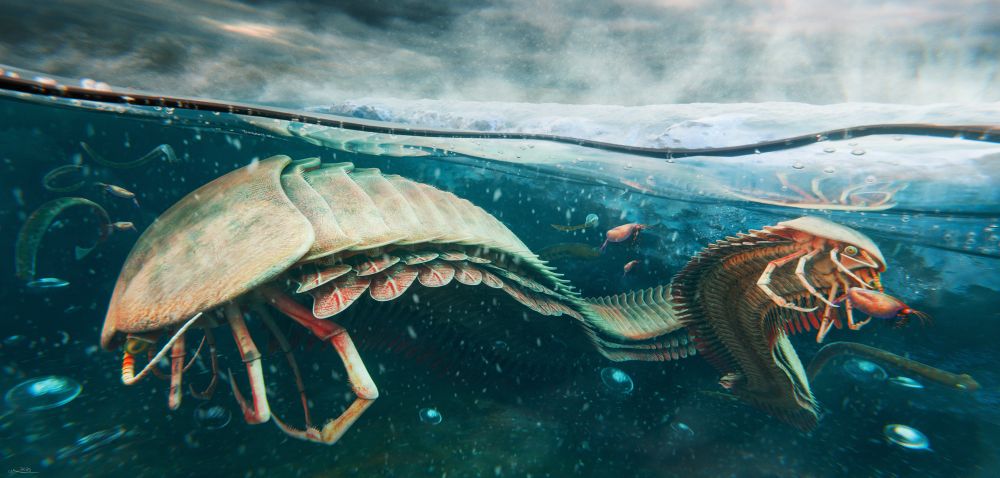
Keurbos susanae, a newly described giant arthropod from the Ordovician-age Soom Shale of South Africa.
29.03.2025 11:06 — 👍 291 🔁 95 💬 13 📌 2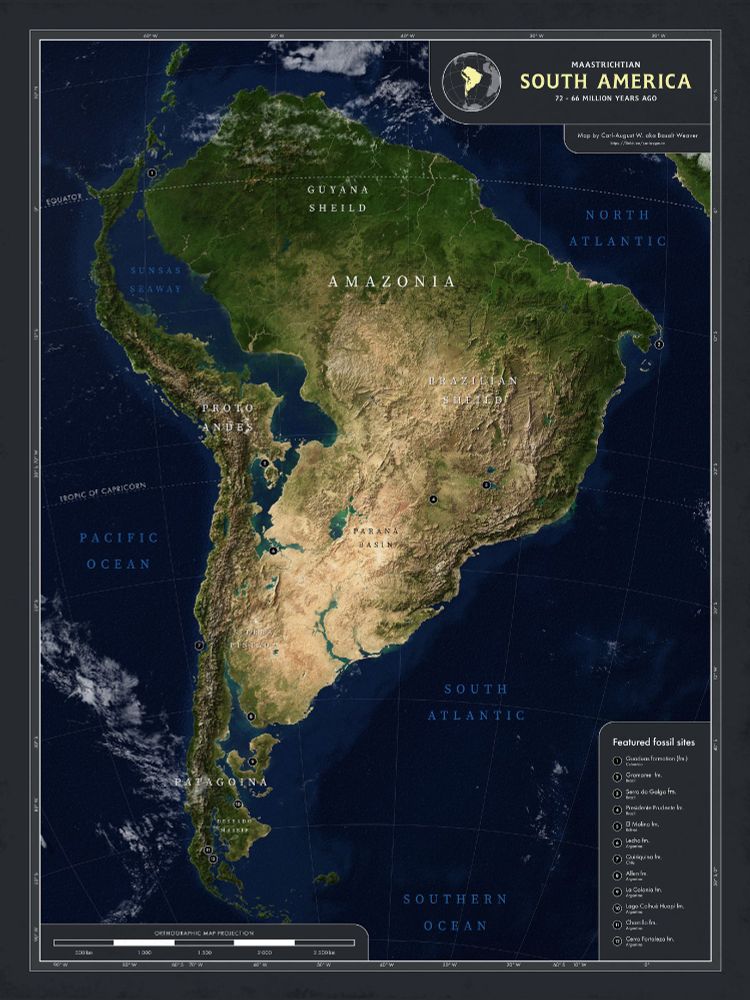
Paleo-art-map of South America during the Latest Cretaceous (Maastrichtian, 72 - 66 MYA).
Original resolution: 75 x 100 cm (300 DPI).
This is the first part of a wider Maastrichtian series that I've been working on over the winter. Sharing another map tomorrow :)
#geology #dinosaurs #sciart
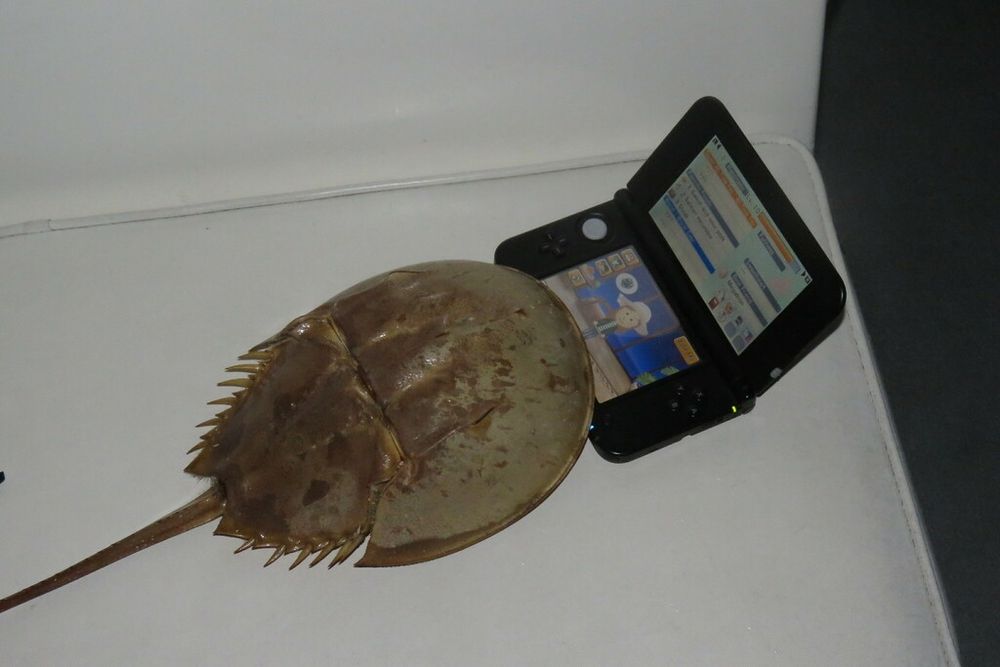
iNaturalist shitposts are now a thing @franzanth.bsky.social @luxomancer.bsky.social www.inaturalist.org/observations...
11.03.2025 23:19 — 👍 150 🔁 46 💬 6 📌 2
Dorsal view of Raninoides benedicti alone on black background. Photo by Arthur Anker. Very elongate, carapace at least 2x as long as wide, true crab. Small abdomen is sticking straight out the back. Claws look like wrenches and multiple distal segments of the legs look like spades. Crab is brown with orangeish mottling. Limbs have blue edges. https://www.crabdatabase.info/en/crabs/brachyura/podotremata/raninoidea/raninidae-4

Plate of colorful raninid crabs including the same image of Raninoides benedicti. Shows the variations within the "family" of frog crabs. Lyreididae. a, Lyreidus tridentatus; b, Lysirude channeri . Raninidae. c, Cosmonotus grayii; d, Flaberhina balabacensis; e, Notopus dorsipes; f, Ranilia muricata; g, Ranina ranina; h, Raninoides benedicti; i, Raninoides lamarcki; j, Symethis variolosa; k, Umalia misakiensis. Plate 39: https://www.publish.csiro.au/book/7895/
Psst: carcinization is not inevitable!
R is for Raninoides, one of the best examples of DEcarcinization. It's a true crab, but its body is elongated and the abdomen sticks out. The wrench and spadelike appendages, and torpedolike body, are good for burrowing (see video, next skeet)
#CrabAZ 🦀🧪🦑

Oviraptorosaurs done for the Prehistoric Nature mod
27.01.2025 01:11 — 👍 4 🔁 1 💬 0 📌 0
For people interested in the #paleostream formation pieces I recommend the interactive map that @montanoceratops.bsky.social build! Also gives you an idea of what blind spots we still have and ideas what to cover next.
montanoceratops.github.io/Formations/

A photograph (left) and line drawing (right) of Aneuroderma oiodes. The photograph shows a beige rock with a beautiful little fossil in it a little over a cm long, picked out by a darker colour. It has really clearly visible antennae at the front, a super cute little head, three well formed limbs, then an abdomen with some long, multi-segmented elements coming off its end - in living groups these have evolved to be the pincers the group is known for, but here they served a different function. Scale bars: 2.0 mm (A, B)

Another member of the Aneuroderma - it looks much like the specimen described in the other image, but the fossil is darker, and the rock lighter, as it is photographed under ethanol
It's #FossilFriday. Meet Aneuroderma a ~165 million year old earwig from NE China. It differs from living earwigs in that instead of ending in those pincers they are so well known for, these animals had (unmodified) multi-segmented elements as seen in some other insects (or cerci).
⚒️🧪🦀🦑 #evosky
*insert band name* aren't real emo, real emo is a small worm like mollusc that crawled around in the mud 430 million years ago, everyone more recent is just a poser
#palaeontology

ティラノミムス、ササヤマグノームス、アルバロフォサウルス、フクイプテリクス、フクイヴェナトル、ヒプノヴェナトル

フクイサウルス、フクイティタン、タンバティタニス、フクイラプトル
Minecraftの世界に日本の恐竜たちがやってくる!
Prehistoric NatureというMOD(『先史時代を駆ける』というシリーズで使って頂いたMODです)で日本の恐竜のモデル(一部はテクスチャのみ)を担当しました。
すぐにすべて実装されるわけではありませんが、徐々に追加していく予定なので続報をお楽しみに!
www.curseforge.com/minecraft/mc...

The Pleistocene Palorchestes azael and its possible ancestor, Propalorchestes novaculacephalus of the Miocene !
Two large, Australian marsupials, lost to time.
#art #paleoart

A drawing mimicking the Minoan Bull-Leaping Fresco found at Knossos Palace in Crete. On a turqoise background, a large deer is leaping into the air. On both sides of it, there are people drawn in the style of Minoan artwork, one dancing, the other holding an amphora, presumably about to offer a drink to the deer. The deer is Candiacervus major, an extinct species that lived on Crete in the Late Pleistocene, with very long and gracile limbs.
I've been drawing scenes of ancient Greeks interacting with endemic Cretan fauna, but Crete had an even older civilization - the Minoans.
In this alternative version of the Bull-Leaping Fresco, people are dancing with and offering a drink to Candiacervus major, a large native deer of the island.

A partial skeleton of an armored dinosaur in a museum display, covered in ocean invertebrates
Sometimes dinosaurs made reefs.
Around 75 million years ago, the body of an armored dinosaur was washed out to sea. De-gassed, the body settled to the sand and began to become a reef before burial. The only known specimen of its species, the fossil was named Aletopelta in 2001. 🧪


Going freshie fresh for #Crustmas - it's the freshwater California Clam Shrimp (Cyzicus californicus)! They're endemic to California & found in vernal pools – their eggs can withstand drying out & can hang out in the dirt waiting for the pools to fill up again. Little taco shrimp! #25DaysofCrustmas
05.12.2024 16:49 — 👍 73 🔁 20 💬 3 📌 0He has in fact been dead for 22 years
04.12.2024 07:36 — 👍 4 🔁 0 💬 0 📌 0
a picture of a prehistoric bird, Sapeornis, reconstructed in the style of a minecraft animal
A large Early Cretaceous bird, Sapeornis, that I modeled for the Prehistoric Nature mod for Minecraft 1.12.
28.11.2024 00:47 — 👍 10 🔁 2 💬 1 📌 0🤓
25.11.2024 21:59 — 👍 2 🔁 0 💬 0 📌 0Don’t mind me hopping onto this but dark and moody #paleoart is my jam!!
#SciArt #artbyjulio

Illustration of extinct narrow-nosed rhino with a map in the background showing it lived in central and southern Europe, northern Africa and some way into western Asia

Illustration of ”Siberian unicorn” or Elasmotherium sibiricum with a map on the background showing it lived in Eastern Europe and central Asia
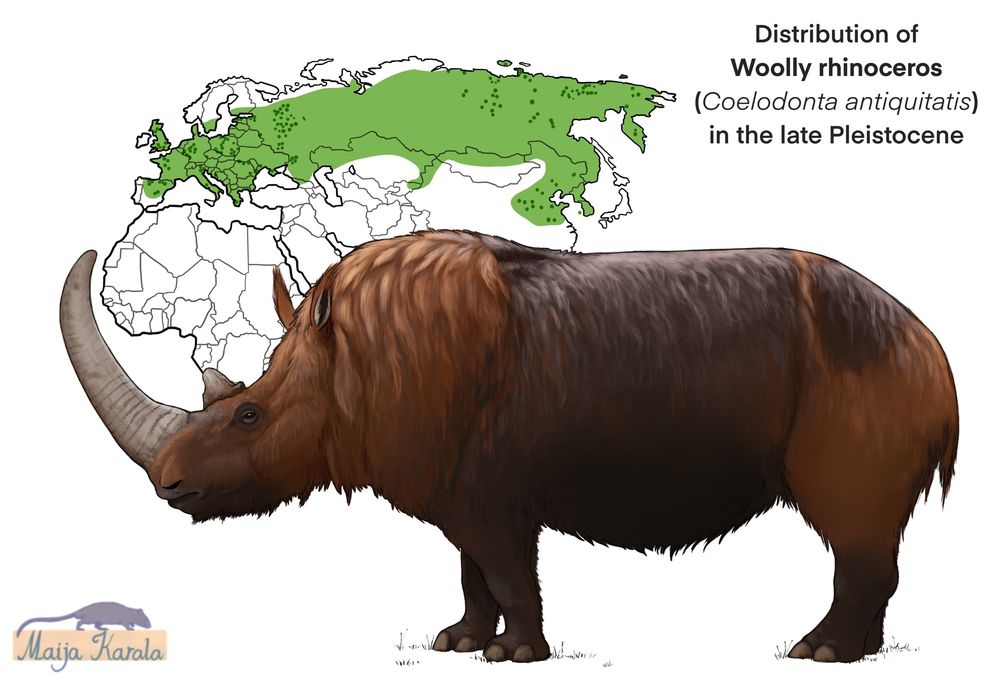
Illustration of a woolly rhinoceros with a map in the background showing it had a very wide distribution from southwestern Europe all the way through Europe and Russia to the Pacific coast and northern China.

Illustration of a merck’s rhinoceros with a map in the background showing it lived in a large area from southwestern and central Europe to western Asia, parts of Siberia and northern and eastern China.
Where did our lost rhinos roam?
Distribution charts based on bone finds (individual dots) and habitat suitability for the four fluffy rhinos of late Pleistocene.
These are of course approximate and might not include all obscure finds. #Sciart
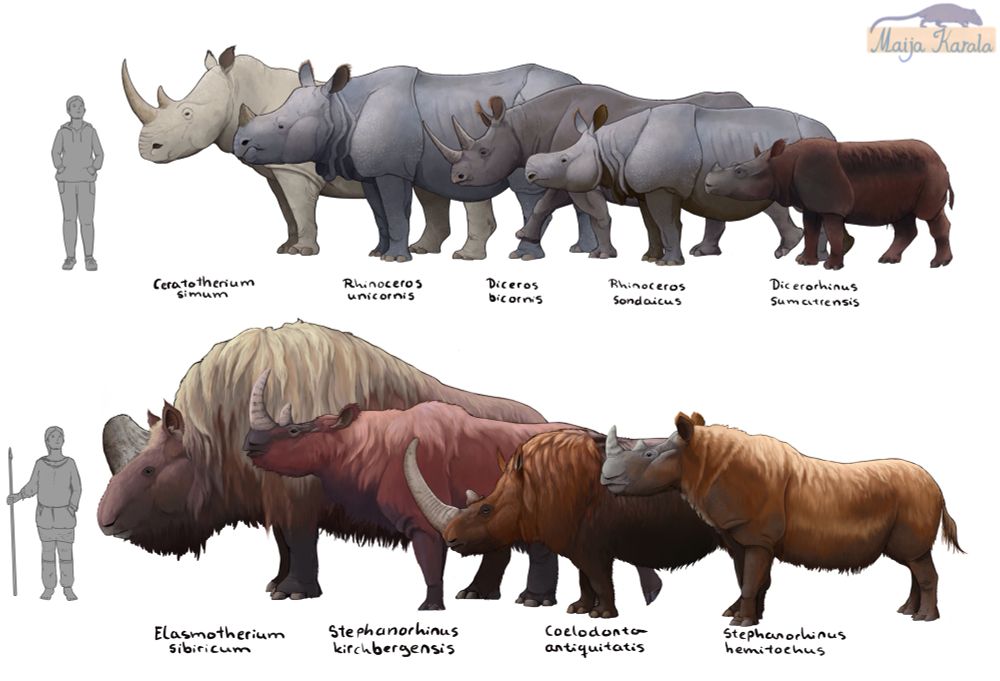
The rhinos we have and the ones we lost.
In the late Pleistocene, about two thirds of the worlds terrestrial megafauna went extinct. Rhinos fared better than average, but still, all the temperate and cold climate species are gone. Those that remain are endangered and in dire need of protection.

a horse fly entirely covered in white hairs, with huge brown eyes that make up most of the head and clear wings, resting on bark
Feeling nostalgic, thinking it's time to post some old favorites for the BlueSky community >>>
One of the most stunning #flies (maybe insects in general) I've seen: #Leucotabanus annulatus, a horse fly (Tabanidae). Males are naturally white, while females are a bit more drab gray/brown. Raleigh, NC
uh oh
#WIP #SciArt #Stanleycaris #isoxys #Blender3D #3Danimation #paleoart #cambrian #reef

Photos of developing beetle larva and dissected 1st instar larva next to mother
they just, um, birth a whole mealworm through their ovipositor I guess
12.11.2024 18:51 — 👍 67 🔁 9 💬 7 📌 0
- A male Voay robustus rests with a female C. niloticus during the breeding season about 1000 years ago.
He´s blissfully unaware that he is the last member of his species, but that's okay.
What's extinction compared to the love of a lady and the warm rays of the sun on your face? -